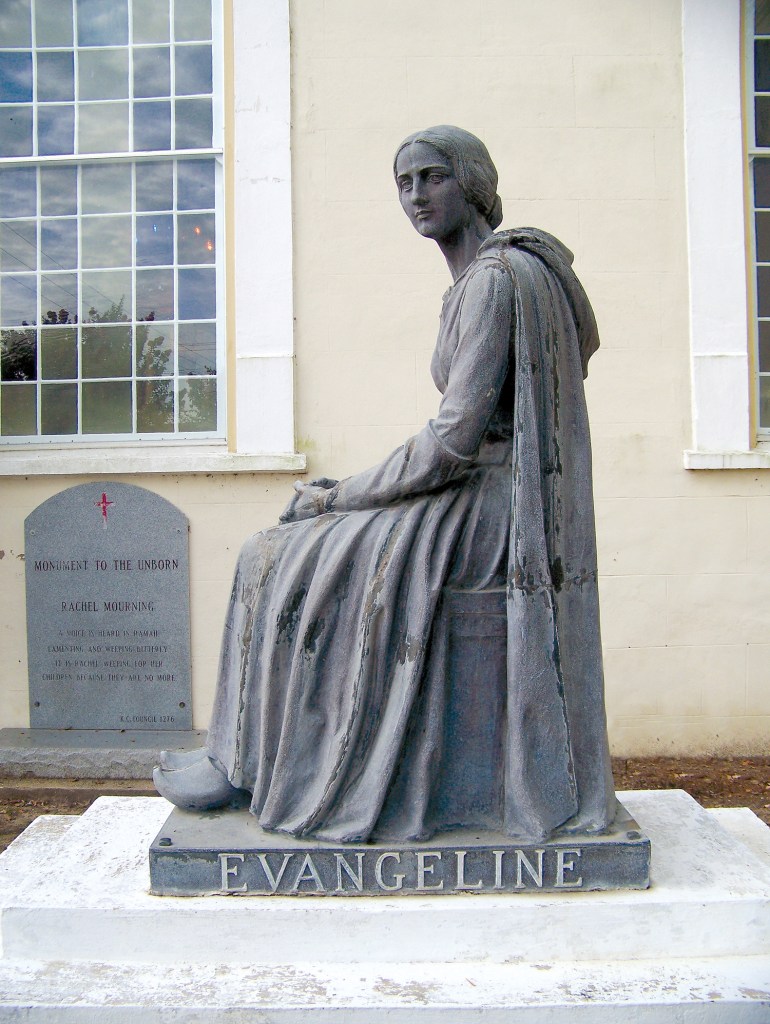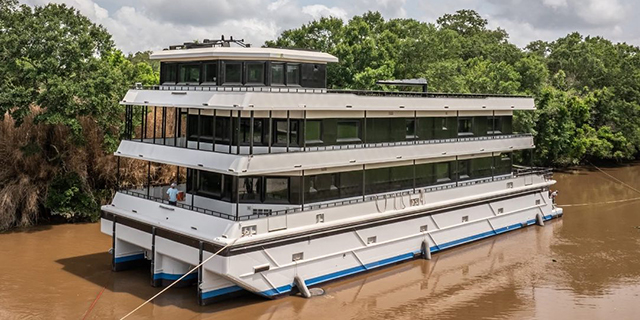Are You Evangeline’s Cousin?
Published 9:58 am Wednesday, August 15, 2012

- Are You Evangeline's Cousin?
Tom Swatloski Found 540,000 Of Evangeline’s Cousins!
Editor’s Note: Henry Wadsworth Longfellow’s epic poem, “Evangeline” is the tragic story of two young lovers separated during the expulsion of the Acadians from Nova Scotia in 1755. As the poem soared in popularity when it was first published in 1847, people all over the world finally understood the plight of the Cajuns, and a love affair with Evangeline was born. She was determined to find her one, true love. Following the success of Longfellow’s poem, other authors wrote different versions of this story about unrequited love. Judge Felix Voorhies published “Acadian Reminiscences: The True Story of Evangeline” in 1907. As he told it, the majestic Evangeline Oak marks the legendary meeting place of Emmeline Labiche and Louis Arceneaux, the real life counterparts to Evangeline and Gabriel. This novel was often taken as historical fact. Around Valentine’s Day each year, there’s a reception held for couples who have either gotten engaged or married underneath the lovely tree. A statue of Evangeline is located in downtown St. Martinville near St. Martin de Tours Catholic Church
Trending
By Barbara Gautreaux
Visit the Parkview Branch of the Iberia Parish Library any day of the week and you will no doubt see Tom Swatloski. The Parkview library is where all documents relating to genealogy are kept, with a dedicated room nearly filled to the brim with stacks of books on the history of the local people. There, among the yearbooks and lengthy compilations will be Tom, typing in updates to his database on Acadian genealogy.
For the past 26 years, Tom has been methodically adding records until he has accumulated information on 540,000 individuals and 225,000 marriages.
“I named my database ‘Evangeline’s 540,000 Cousins,’” says this 90-year-old of Polish descent, who has spent half of his life in New Iberia. The information in Tom’s database is from historical documents and local obituaries, and it allows a user to enter a family name and see the connections back for generations.
Tom allows library visitors to use his information free of charge and indeed, the U.S. Supreme Court has ruled that the facts and dates of history cannot be copyrighted. “I just want to make this information available to as many people as possible,” he says.
In fact, Tom has offered his database of information to as many people as possible, via the Internet. He has given his entire database to Acadiana LifeStyle, for a section of genealogy which included on its website, www.acadianalifestyle.com. The provider of the access software, Brother’s Keeper, is able to do this via its web hosting company, WebBro.
Trending
Tom is aware of how important genealogy is to the Acadian people, whose ancestors were forced to leave Nova Scotia in 1755 but also valued their church records enough to bring them along. He has not been so lucky with his own family history, where many records were lost over Europe’s war-torn landscape.
“I was so frustrated with the Swatloski side,not finding anything on my great-grandfather until just recently,” he says. He found himself instead researching his wife’s family, and French Acadian families.
By focusing on the history of Acadians who settled in this area of Louisiana, Tom has been able to assemble information that will help individuals trace their family tree back to biblical times.
“If you trace Elizabeth Windsor—the Queen of England—the genealogy will go back to Adam—except for one section with the prophet Jerebon,” he says. “I knew what tribe he belonged to but I didn’t know all the connections, so I skipped him to go on to the son of Jacob.”
Teaching & Learning
Tom Swatloski grew up in a Polish Catholic family in Houston, Texas,with seven boys and seven girls. It was the lean years of the Great Depression, but his parents, Pearland Stanislas “Stash” Swatloski were still able to adopt a niece that needed a home. The family lived on fresh vegetables from his grandmother’s truck farm, and Tom carried his lunch to the Dominican Sisters Catholic School seven blocks from his home.
“When I was 13 and in the 7th-grade, a Christian Brother from Lafayette visited and recruited me for the Christian Brothers. At 13 I left home and went to Lafayette to be trained to be a Christian Brother.”
It was 1935 and Houston had a population of 139,000 people while Lafayette’s population was only 14,000. For Tom the experience was like coming to the country, and he studied at the high school known as DelaSalle.
The Christian Brothers are a Catholic lay religious order for men formed by Saint Jean-Baptiste de La Salle in 1680. Members don’t marry; they live in a community, share meals and residence, and dedicate themselves to teaching religious school. He says, “We called ourselves monks. We took three vows: poverty, chastity and obedience.” The Christian Brothers made up the largest Roman Catholic male order, numbering about 14,000 members at the beginning of the 20th century, with more than 2,000 schools.
In 1941 Pearl Harbor was attacked and everybody wanted to join the military. At age 19, Tom went to sign up and was told he was too young. “They didn’t allow you to go at 18. At that time there was a draft and you had to be 21,” he says. Because he was a Christian Brother, the superiors advised him that if he joined the military, he could not return. “They had put six years of training in to us and what we were doing was an important job too, so I didn’t go into the military. All of my brothers did.”
Tom began a 44-year-long teaching career that began at St. Peter’s College in New Iberia, teaching elementary school to young boys on Main Street.He says many of New Iberia’s most successful businessmen were taught by him. After two years he was sent to Mexico.
“I got a letter saying I would study Spanish over the summer and begin teaching school in Monterey, Mexico in three months,” says Tom. Relocated 150 miles south of Laredo,Texas, Tom began teaching, working in the school book store and driving a school bus, all in one day. “I was selling books to 700 students, so I learned Spanish very fast.”
Tom spent six years in Mexico,writing a weekly letter to his parents at home. He was reassigned in 1950 to Galveston and eventually to Delasalle, teaching at his alma mater. As he taught and moved around to assignments, Tom began a hobby of amateur radio. He learned to build radio equipment from surplus B29 plane equipment and was able to communicate with missions in Central America. “It was a helpful hobby.” This hobby became even more important during the Vietnam War when Tom could connect U.S. soldiers recuperating on the island of Guam to their families in the U.S.
“With a phone patch that I built, we would get the patient on the line. I would place a collect call, long distance to their families. The family would agree to take the call and I would patch the soldier through—phone to phone.
“Often these families were getting their first news about their loved one, who was injured and in the hospital, from these radio-telephone calls.” At that time they monitored about 200 stations, patching in one call after another, until communications would go out, late at night.
Tom continued his interest in amateur radio to home computers, eventually training other teachers how to use these new machines.
“A first grade teacher once told me that our brains have curls in them,” says Tom. “Every time we use our brains we get more curls and more brains. But every time we don’t use our brains the curls would dry up and fall off. I didn’t want that to happen to my brain.”
Marriage & Grandchildren
Did Tom leave the Christian Brothers and fall in love or did he fall in love and then leave? It’s kind of half-and-half, he says, about his marriage to Mildred Miller Simon, a teacher at Mt. Carmel Academy in New Iberia. Her husband had died young and she was a widow with three children, the youngest in high school. “I was 43-years-old at the time, and we were married for almost 40 years,” says Tom.
At age 55 Tom learned to speak French as a requirement to directing a bilingual program in the school system. “You are never too old to learn,” he says. Mildred and he spent a summer in Canada,north of Quebec City,where they wouldn’t hear a word of English. They also spent a summer in France.
Tom eventually retired, taking on the hobby of genealogy, and the task of entering Father Donald Hebert’s massive church archives into his Evangeline’s Cousins database. “My wife was very understanding,” he recalls. “When I first started on this, she said, ‘We don’t know all those people, why are you doing that?’ With the church records, I eventually had her family researched all the way back to the 1600s.”
Mildred passed away in 2004 and Tom, or ‘PaPa’ is extremely proud of his six grandchildren and 10 great-grandchildren. He continues to walk a mile a day, and having beat cancer 10 years ago, Tom states, “I haven’t been back to see my doctor since. He actually retired!” Now his physicians are his granddaughter, Dr.Beth Clarke and her husband, Dr. Drew Clarke. His room at Azalea Estates is full of computer equipment and he is interested these days in arrowheads or “stone points.”
There are lessons still to be learned and Tom plans to keep learning for as long as he can. “That is why the good Lord has given me all these years on earth. I can’t figure out any other reason, except to keep learning.”





